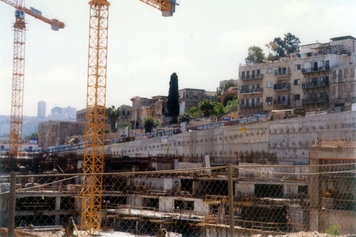
Modern construction in the Port area, Arab houses in the background.
|
 Modern construction in the Port area, Arab houses in the background. |
|
Marie Sama'n, Haifa, April 6, 1999:
|
|
The Sama'n family live low down in the old Arab quarter of Haifa, towards the Port. Marie is just old enough to remember the Nakbeh. She is unmarried and lives with her mother. Her sister Rosa who lives close by is visiting with her two daughters. It's Easter and leftist Palestinians keep the feast traditions like everyone else, with visits and the date-filled cakes called 'ma'moul' that should be made at home.
The Samaan family is originally from Sohmata, and it's Wajih Sama'n, president of the Ibna' Sohmata association, who guides me to their home. Most destroyed villages in Galilee have formed committees like that of Sohmata, that undertake commemorative activities such as annual visits, repairing mosques and churches, or exhibitions of artifacts from before the expulsions. One of Marie's nieces criticizes the Ibna' Sohmata for being undemocratic and excluding women from the directing committee. Tension between generations is never far away in Palestinian families anywhere in their diaspora, raised above normal by crisis. Expelled from their village in 1948, some of Sohmata's people took refugee in Lebanon, others went to the nearby village of Fassuta.3 Marie's father soon moved to Haifa in search of work. He was a communist party member, a connection that at the beginning of Israeli rule helped some Palestinians to find jobs. Marie worked for the party from an early age, distributing pamphlets and later with the Harakat al-Nissa'i (Women's Movement). The neighbours gossiped but her father supported her. She gives a good narrative, a story of |
poverty, hard work, and party loyalty, unpretentious but rich in social detail.
Marie Samaan begins by saying:
|
[Arrival in Haifa] [Samia Shehadeh] Copyright©2005 |
|